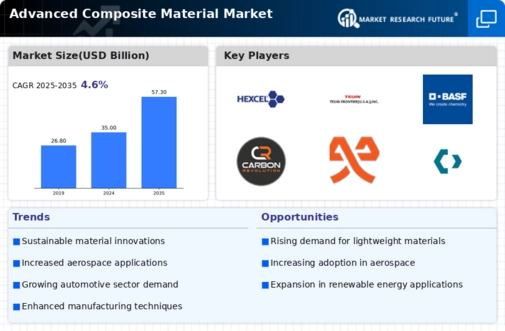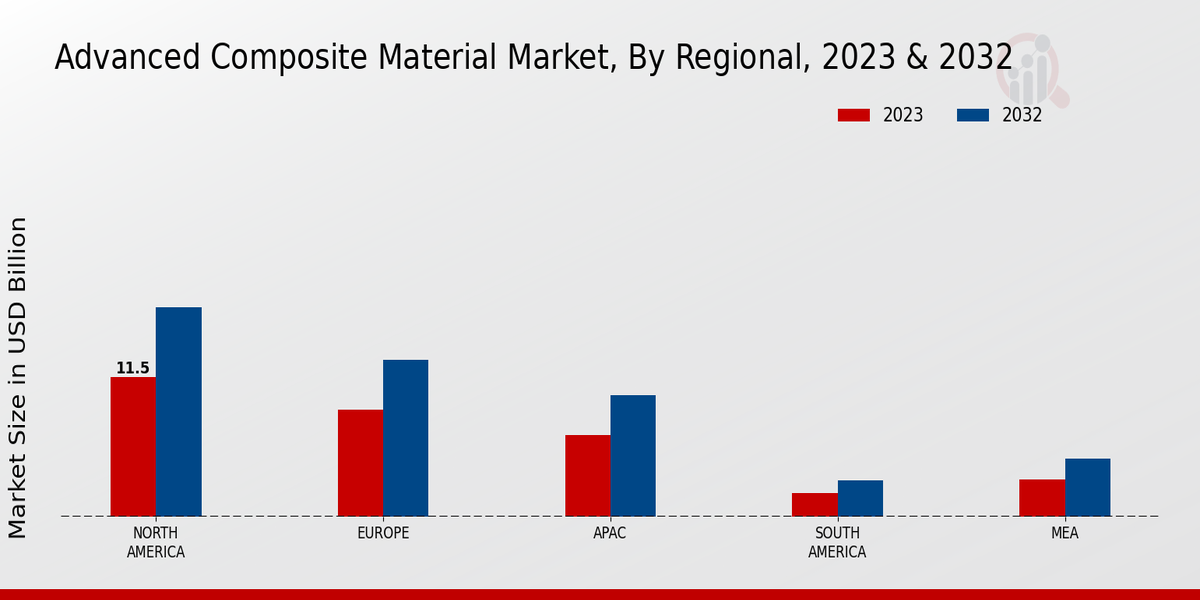Market Growth Projections
The Global Advanced Composite Material Market Industry is poised for substantial growth, with projections indicating an increase from 35.0 USD Billion in 2024 to 57.3 USD Billion by 2035. This growth trajectory reflects a compound annual growth rate (CAGR) of 4.57% from 2025 to 2035. The expanding applications of advanced composites across various industries, including aerospace, automotive, and renewable energy, are driving this upward trend. As manufacturers continue to innovate and develop new composite materials, the market is likely to witness increased investment and interest from stakeholders. This positive outlook underscores the importance of advanced composites in future industrial applications.
Rising Automotive Applications
The automotive industry is progressively integrating advanced composite materials to improve vehicle performance and fuel efficiency. The Global Advanced Composite Material Market Industry is likely to benefit from this trend, as manufacturers seek to reduce vehicle weight while maintaining structural integrity. Composites are being utilized in various automotive components, including body panels and interior parts, contributing to a more sustainable production process. As electric vehicles gain traction, the demand for lightweight materials is anticipated to surge, further propelling the market. This shift aligns with the industry's goals of achieving lower emissions and enhanced energy efficiency, indicating a robust growth trajectory for the sector.
Growing Demand in Aerospace Sector
The aerospace industry is experiencing a notable increase in the adoption of advanced composite materials, driven by the need for lightweight and high-strength components. The Global Advanced Composite Material Market Industry is projected to reach 35.0 USD Billion in 2024, largely due to the aerospace sector's focus on enhancing fuel efficiency and reducing emissions. Aircraft manufacturers are increasingly utilizing composites for wings, fuselage, and other critical components, which not only improves performance but also contributes to sustainability goals. This trend is expected to continue, as advancements in material technology further enhance the properties of composites, making them indispensable in modern aerospace applications.
Emerging Markets and Global Expansion
Emerging markets are becoming increasingly significant in the Global Advanced Composite Material Market Industry, driven by industrialization and infrastructure development. Regions such as Asia-Pacific and Latin America are witnessing a surge in demand for advanced composites across various sectors, including construction, automotive, and aerospace. As these economies grow, the need for lightweight and durable materials is expected to rise, presenting opportunities for manufacturers. The projected CAGR of 4.57% from 2025 to 2035 indicates a robust growth outlook, as companies expand their operations to meet the evolving demands of these markets. This expansion is likely to foster innovation and competition within the industry.
Increased Investment in Renewable Energy
The renewable energy sector is increasingly utilizing advanced composite materials, particularly in wind turbine blades and solar panel structures. The Global Advanced Composite Material Market Industry is expected to see substantial growth as the demand for sustainable energy solutions rises. Composites offer advantages such as lightweight properties and resistance to environmental degradation, making them ideal for renewable energy applications. As countries worldwide commit to reducing carbon footprints and transitioning to cleaner energy sources, investments in advanced composites for renewable technologies are likely to increase. This trend not only supports sustainability goals but also contributes to the overall expansion of the composite materials market.
Technological Advancements in Material Science
Innovations in material science are playing a pivotal role in the expansion of the Global Advanced Composite Material Market Industry. Continuous research and development efforts are yielding new composite formulations that exhibit superior mechanical properties and durability. These advancements enable the production of composites that can withstand extreme conditions, making them suitable for a broader range of applications, including marine and construction sectors. The introduction of smart composites, which can respond to environmental changes, is also gaining traction. As these technologies evolve, they are likely to enhance the performance and applicability of advanced composites, thereby driving market growth and diversification.














